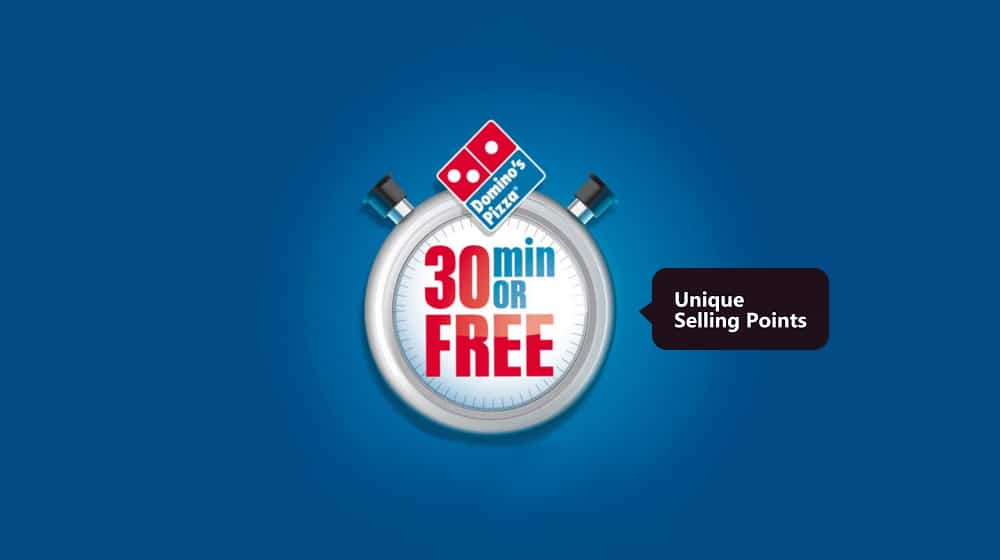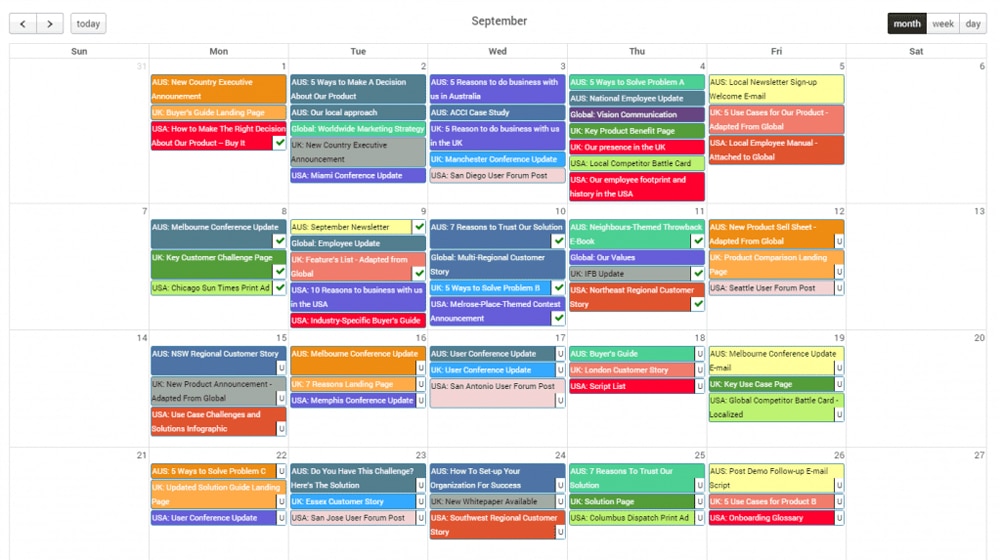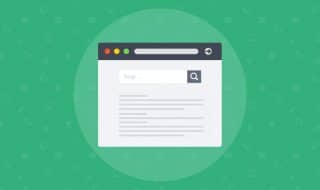A Step-by-Step Guide to Building a Blog Content Strategy

Possibly one of the biggest mistakes I see with people running blogs is not having a plan. Too many people think that blogging is an easy thing to do, that you can write about whatever strikes your fancy and rake in the viewers.
The reality is, there are approximately a trillion blogs on the internet, all of them competing for the limited attention of the people browsing at any given time. Search engines try to filter this infinite mass of content to figure out what's worth showing to people, which is why SEO and Google are so important.
Without a plan, how can you gain the attention of the search engines, let alone the people who are browsing? Without a plan, how can you know what to change moving forward to better adapt to market pressures, audience attention, and search engine requirements? Without a plan, how can you even begin to succeed?
The answer is: you can't.
This is why hundreds of marketing blogs have written guides to creating a content strategy, and it's why I'm writing one too. If I can convince even one of you to create a plan, it will have been worthwhile.
For the purposes of this guide, I'm going to assume you have the absolute basics down. Some guides start from nothing, and walk you through picking a web host, setting up a blog with WordPress and a theme, setting up permalink structures, and so on. I figure you already know how to do all that, and you're looking for more overarching strategy and planning instructions.
 30 Second Summary
30 Second Summary
You need a solid plan to succeed with your blog since you're competing against countless others for attention. Before starting, you should think about your timeline - it often takes years to see real success. You have to know what makes you different from others and who you want to reach. Set both long-term goals (like becoming an industry leader) and short-term ones (like growing readers 10% monthly). You should post at least 11 times monthly and keep track of topics, keywords and results in spreadsheets.
Understand the Time Scale

Before you can begin to create a blogging strategy, you first need to understand the time scales involved. Virtually none of the blogs created this year will show positive returns next year. In fact, it can take several years for a blog to grow into what you might call a success. The exceptions are cases where you have an established brand or thought leader behind them. For example, if Neil Patel decided to start a new blog, it would likely be a success almost immediately, due to name recognition and the sheer amount of resources he can throw at it.
Read this post for a deeper insight into how long it takes for blogging to start working, and how long you may have to wait to see returns. Remember, blogging is a long-term strategy, so you need to be thinking in terms of what you want a year, two years, or five years from now, not just next week or next month.
Define Your Unique Selling Points

This applies to your blog's call to actions, the topics you pick, your product, and more.
What does your business, brand, or CEO have to offer that other businesses don't? What do you bring to the table that your competitors don't?
The USP, or Unique Selling Point, is what makes your business different from the rest. Are you smaller and more agile than the competition? Are you catering to larger or smaller customers than most others in your niche? Do you have a unique take on a common problem?
Knowing your USP is crucial for planning out content later. Much of your content should be aimed towards showcasing why a certain problem is a problem, and why your USP is the right thing to solve it. Otherwise, more established competitors are just going to eat your slice of the pie out from under you.
Understand Your Audience

In addition to knowing what your business has to offer to your audience, you need to know who your audience is and what they want to get out of your business. You need to know this for two reasons: so you can provide them what they want, and so you can guide them to change what they want to suit what you want to give them.
For example, if your site has historically provided a lot of tutorials and informational articles, that's great for attracting users, but not so good for selling products. When you know that's why users are coming, though, you can start to adjust their expectations and start leading them towards buying your products to help them solve problems.
How can you learn all about your audience? This guide gives you a good range of questions you can ask yourself and resources you can use to learn. Analytics, surveys, demographics, readership statistics; it's all useful information to put in context.
Define Long Term Goals

What do you want your blog to accomplish? There are any number of possible goals, such as:
- Providing cutting edge information, case studies, and resources to position your business as an industry resource.
- Curating content and writing overarching reviews to make your business a go-to source for timely news and relevant information.
- Creating a wealth of content that encourages users to make a purchase, so your blog becomes a source of conversions.
- Creating high-profile content that draws in links, social shares, and traffic, to position yourself as a thought leader in your industry.
These are long-term goals that won't happen over night, but which can be worked towards in general throughout all of your content. They also aren't mutually exclusive; most blogs can fit most or all of those categories. The point is to make sure you produce content for your blog that hits each goal at least once a month, so you're actively progressing towards all of them.
Define Short Term Goals
Short-term goals are both easier to achieve and more specific. Rather than "be a thought leader", you should be looking at tangible, measurable goals like "draw in 10% more readers than last month" or "actively promote products and achieve at least 5 more conversions than normal."
Short-term goals should be something you can reasonably achieve within the space of 3-12 months. They should also allow you to sub-divide them down to even more narrow goals which can be applied to individual blog posts. "This post is aimed at selling products" or "this post is meant to develop backlinks" are good goals for individual posts.
Determine a Posting Frequency

How often should you be posting new content to your blog? Every new post is an opportunity to bring in new readers, new conversions, new followers, new social media shares, new links, and everything else you want your blog to be bringing in. On the other hand, the more frequently you blog, the more you're going to plow through your content ideas list, and the more you have to spend in terms of time and/or money on creating your content.
Studies have shown that a minimum of 11 posts per month is a good baseline. That's about three per week. The more you post, the more traffic you'll generally get, but there tends to be some level of diminishing returns depending on what your goals are and how varied your topics can be.
Personally, I like to ramp up content and publish every day for a brand new site, until I've built up a backlog. I then drop down to 1-3 posts per week, again depending on the goals and the content ideas I have. Some sites work best with multiple shorter posts per week, while others work best with only one post per week, but with a longer word count and more effort put into it.
Create Some Spreadsheets

Once you have the broad concepts down, it's time to start getting into specific mechanics, and that means spreadsheets. I like to maintain two:
The first spreadsheet is my sheet for topic ideas and content ideation. One column has primary keywords. The second has spin-off long-tail keywords from that keyword. The third has any noteworthy existing content for that topic idea. A fourth has multiple specific headline ideas, when I feel like generating them. Columns 5+ have any data I want to scrape, like search volume for the keywords.
The second spreadsheet is a content record. This is a spreadsheet that records the content I've already created, so it's easier to remember what I've covered and what I haven't. The first column is the specific blog post title. The second is the URL for the post on my site. Additional columns contain the primary keywords, the publication date, and the author if applicable. Additional keywords, to be filled in later, include statistics like first-month traffic and social media shares.
Do Broad Keyword Research

Your business has an industry and a niche. Broad keyword research takes these and looks for any keywords you can come up with that might be relevant. I like to use a sort of snowflake method. Each major prominent keyword has a core circle around it. Something like "marketing" or "sales" or "shoes". Each of these spins off into first-tier keywords, like "content marketing" or "landing pages" or "running shoes". From there, each one spins off into narrower and narrower topics.
You're never going to write content targeting one of these keywords, not really. The phrase "content marketing" has almost 63,000,000 results on Google search. How can you write something good enough to be in the top 10 of those results?
No, these broad keywords exist so that you can spin off further topic ideas.
Do Narrow Keyword Research
Once you start getting down into specific semi-broad keywords from up above, you can start using them to generate long-tail keywords that are worth targeting. Long-tail keywords can be things like "how to write a tutorial" or "Halloween costumes for babies" or "reflective running shoes". They're specific, narrow topics that you can use to write one or a couple of blog posts.
This is where you start getting into using specific tools to perform your research. You want to find phrases that are identical or similar to phrases people are actually searching for, while also being relevant to your overarching topics.
I like to categorize these keywords when I write them down. Is this keyword part of a query where the user is looking for information in a general sense, looking for instructions in a specific sense, or looking to make a purchase? The intent behind the keyword helps inform the kind of content you produce for it.
Generate Topic Ideas

You need more than just a keyword to create a blog post: you need a topic. Long-tail keywords sometimes have topics attached, such as "the basics of on-site SEO". Others might be more free-form, like "Halloween costumes for babies" can spin into "The Top 15 Halloween Costumes for Babies" or "The Worst Halloween Costumes for Babies" and everything in between.
I always recommend generating as many ideas as you can, both good and bad, and don't worry if content with that topic already exists. If you try to be completely unique, you'll never succeed. Bad ideas may have a place as something you can spin into a good idea later.
Trust me on this one: having a document with a few thousand content ideas will come in handy every time you're struggling to come up with something to write for next week.
Look for Old Content to Replace
The web is full of content on every subject, ranging from timely news pieces with no relevance to the modern day, to evergreen guides that are updated once a month with new and useful information.
One of the best resources you have for creating content for your site is this old content. A lot of blogs simply don't update their content, so you can often find posts that would be great and relevant with new information, but are languishing with no attention. These are opportunities for you to poach the keyword and create your own content with better, more up to date information.
In cases where content is old enough to have disappeared from the web, you can even embark on a campaign of broken link building and similar advertising strategies to take advantage of it.
Set Up RSS or Monitoring for Competitor Blogs

One thing I like to do at around this stage is set up an RSS feed or a series of alerts that monitor my competitors and other industry blogs. These people are all working on their own content marketing strategies, and you know what? There's nothing wrong with watching them to see what they do.
Some of the content they publish will be unique to them, but it can still give you an idea of how to cover the same topics on your site. Some of it will be more broadly general, and you can try to "do what they did, but better." Yet other pieces of content might take a stance on an opinion or issue, and you can write a direct rebuttal piece, or a piece supporting it. Just because they're a competitor doesn't mean you can't link to them to refute their points, right?
You can use services like Feedly to store all your blog RSS feeds, and group them into categories. That way, any time you check your Feedly account, it will simultaneously show you the latest updates on hundreds of blogs at a glance. This is a fantastic way to get your creative juices flowing, and it can help you spot trends and catch up on industry news.
Create a Content Calendar
I strongly recommend using some kind of tool or plugin to manage an editorial calendar. WordPress has some excellent plugins that tie into your CMS directly, but you can also use something like Google Calendar if you want a system accessible to people who aren't directly within your organization or who have access to your dashboards.

A good content calendar should show your overall content themes and plans, such as "this month can focus on summer posts" and "this month is a lead-up to holiday sales and should focus on promoting products more", while also having a precise schedule for content you've been producing.
Your calendar should allow you to see content you've scheduled already, content you've planned but haven't scheduled, and any open slots in your calendar. If you're using a dedicated plugin, it might also allow you to shuffle your schedule around without having to change dates on every post manually, to add and remove posts from your schedule as topics and news changes.
Make Sure Each Post Has a Purpose
When you're actually producing content, try to make sure that every post has a purpose. That purpose might be to inform your readers of a breaking piece of news, or to instruct them on how to solve a problem, or some other informational fulfillment. It might also be to focus on sales, by leaning in on the benefits of your product, or the detriments of a particular problem your product solves. It might be to become an industry resource that draws in links, not necessarily to go viral, but to be a resource for future bloggers within your industry.
If you're writing a post and you can't answer the question of "what does this post do for my content plan", you might want to start over and figure that out first.
Keep Old Content Up to Date

One key to blogging success that all too few people actually do is keeping old content up to date. If you've ever searched for a resource guide and found it hasn't been updated in 3, 5, or more years, you know this pain. Users want modern, relevant information. Keep your content up to date whenever anything important changes.
Before you start feeling like every post you publish needs to be updated, though, keep in mind that anything that relies on timely announcements, like news posts, can be left to languish. It's only the evergreen content and long-term valuable guides that need to be shined up every six months or so.
Set Up Blog Success Monitoring
Remember way up top where I mentioned that blogging can take a long time to ramp up and show returns? Well, a huge part of keeping up your motivation to keep blogging is monitoring that growth. Keep an eye on key metrics like backlinks, website traffic, and conversions, and monitor them.
It's important to do this to be able to see the gradual upward trend, as proof that your efforts are working, even if it's slow.
It's also important to do this so you can see if something you post doesn't work, or works better than normal. It's possible that, over time, you drift off topic and start to lose your engaged audience. Alternatively, it's possible that one of your key focuses has been off, and by hitting an off-beat note, you capture a segment of attention you were missing before. It's important to recognize these moments and adjust your strategy accordingly.



 30 Second Summary
30 Second Summary



July 28, 2020
Apart from using Google Analytics for metric checking, do you use other apps or software to see the progress overall including the social media metrics?
July 28, 2020
Hi J! I like using Ahrefs to see which of my content is getting mentions on other blogs. Even if those posts aren't getting a lot of traffic, if they are getting good links, that is valuable in it's own right, and it's interesting to see and understand why that's happening. Some blog posts are more link-worthy than other, like giant resource lists or downloadable resources, so they are a sort of natural lead magnet.
I also use Google Search console to get an idea of my click-through rate and traffic from Google. If certain posts have a very low click-through rate, it could be that my title isn't very good and could use improving. A simple change of a blog topic could make a drastic difference on how many people are going to click it, and this is data that you can only find in Google Webmasters.
Here are some blog posts on these subjects that we've written:
Tracking sales in Google Analytics: https://www.contentpowered.com/blog/track-sales-blog-analytics/
How to tell if your blog is working: https://www.contentpowered.com/blog/does-blogging-actually-work/
June 26, 2022
I've been hearing so much about Ahrefs since we started blogging. I think it's time we check it out.
December 07, 2021
You've got some great tips here, James. I have been neglecting to monitor my blog's growth because it's been a bit depressing to see lately, to be honest. But what you said reminded me that instead of being too negative, I can instead take those insights to see where I need to put the work on. Thanks again for sharing this!
December 07, 2021
Hey Sharon!
Absolutely - the fact it takes so long for a blog to be successful makes it really tricky to monitor for progress.
That, coupled with the fact that so many people are writing about the wrong topics, makes it really frustrating.
Even if you do everything right, a new blog can take 1-2 years to really take off. If you're not doing everything right, you could just be spinning your wheels.
Stay persistent!